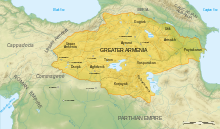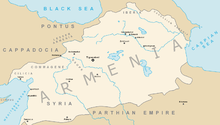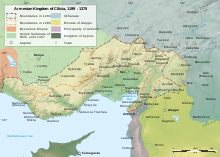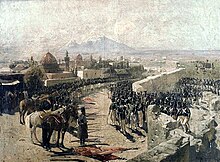Armenia
Republic of Armenia Հայաստանի Հանրապետություն Hayastani Hanrapetut’yun (Armenian) | |
|---|---|
 | |
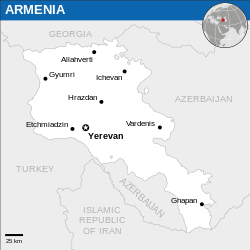 | |
| Capital and largest city | Yerevan 40°11′N 44°31′E |
| Official languages | Armenian[1] |
| Ethnic groups (2011) | |
| Religion | Christianity[4] |
| Demonym(s) | Armenian |
| Government | Unitary parliamentaryrepublic |
| Armen Sarkissian | |
| Nikol Pashinyan | |
| Ararat Mirzoyan | |
| Legislature | National Assembly |
| Establishment history | |
| 6th century BC | |
• Kingdom of Greater Armenia united under the Artaxiad Dynasty[6] | 190 BC[5] |
| 52–428 | |
| 885–1045 | |
| 1198–1375 | |
28 May 1918 | |
| 21 September 1991 | |
| Area | |
• Total | 29,743 km2(11,484 sq mi) (138th) |
• Water (%) | 4.71[7] |
| Population | |
• 2016 estimate | 2,924,816[8] |
• 2011 census | |
• Density | 101.5/km2(262.9/sq mi) (99th) |
| GDP (PPP) | 2019 estimate |
• Total | $31 billion[11] |
• Per capita | $10,572[11] |
| GDP (nominal) | 2019 estimate |
• Total | $12 billion[11] (132nd) |
• Per capita | $4,244[11] (116th) |
| Gini (2016) | medium |
| HDI (2017) | high · 83rd |
| Currency | Dram (֏) (AMD) |
| Time zone | UTC+4 (AMT) |
| Driving side | right |
| Calling code | +374 |
| Patron saint | St. Gregory |
| ISO 3166 code | AM |
| Internet TLD | |
Armenia (/ɑːrˈmiːniə/ (![]() listen);[13] Armenian: Հայաստան, translit. Hayastan, IPA: [hɑjɑsˈtɑn]), officially the Republic of Armenia (Armenian: Հայաստանի Հանրապետություն, translit. Hayastani Hanrapetut'yun, IPA: [hɑjɑstɑˈni hɑnɾɑpɛtutʰˈjun]), is a country in the South Caucasus region of Eurasia. Located in Western Asia[14][15] on the Armenian Highlands, it is bordered by Turkey to the west, Georgia to the north, the de facto independent Republic of Artsakh and Azerbaijan to the east, and Iran and Azerbaijan's exclave of Nakhchivan to the south.[16]
listen);[13] Armenian: Հայաստան, translit. Hayastan, IPA: [hɑjɑsˈtɑn]), officially the Republic of Armenia (Armenian: Հայաստանի Հանրապետություն, translit. Hayastani Hanrapetut'yun, IPA: [hɑjɑstɑˈni hɑnɾɑpɛtutʰˈjun]), is a country in the South Caucasus region of Eurasia. Located in Western Asia[14][15] on the Armenian Highlands, it is bordered by Turkey to the west, Georgia to the north, the de facto independent Republic of Artsakh and Azerbaijan to the east, and Iran and Azerbaijan's exclave of Nakhchivan to the south.[16]
Armenia is a unitary, multi-party, democratic nation-state with an ancient cultural heritage. Urartu was established in 860 BC and by the 6th century BC it was replaced by the Satrapy of Armenia. The Kingdom of Armenia reached its height under Tigranes the Great in the 1st century BC and became the first state in the world to adopt Christianity as its official religion in the late 3rd or early 4th century AD.[17][18][19] The official date of state adoption of Christianity is 301.[20] The ancient Armenian kingdom was split between the Byzantine and Sasanian Empires around the early 5th century. Under the Bagratuni dynasty, the Bagratid Kingdom of Armenia was restored in the 9th century. Declining due to the wars against the Byzantines, the kingdom fell in 1045 and Armenia was soon after invaded by the Seljuk Turks. An Armenian principality and later a kingdom Cilician Armenia was located on the coast of the Mediterranean Sea between the 11th and 14th centuries.
Between the 16th and 19th centuries, the traditional Armenian homeland composed of Eastern Armenia and Western Armenia came under the rule of the Ottoman and Iranian empires, repeatedly ruled by either of the two over the centuries. By the 19th century, Eastern Armenia had been conquered by the Russian Empire, while most of the western parts of the traditional Armenian homeland remained under Ottoman rule. During World War I, Armenians living in their ancestral lands in the Ottoman Empire were systematically exterminated in the Armenian Genocide. In 1918, following the Russian Revolution, all non-Russian countries declared their independence after the Russian Empire ceased to exist, leading to the establishment of the First Republic of Armenia. By 1920, the state was incorporated into the Transcaucasian Socialist Federative Soviet Republic, and in 1922 became a founding member of the Soviet Union. In 1936, the Transcaucasian state was dissolved, transforming its constituent states, including the Armenian Soviet Socialist Republic, into full Union republics. The modern Republic of Armenia became independent in 1991 during the dissolution of the Soviet Union.
Armenia recognises the Armenian Apostolic Church, the world's oldest national church, as the country's primary religious establishment.[21][22] The unique Armenian alphabet was invented by Mesrop Mashtots in 405 AD.
Armenia is a member of the Eurasian Economic Union, the Council of Europe and the Collective Security Treaty Organization. Armenia supports the de factoindependent Artsakh, which was proclaimed in 1991.
Contents
Etymology
The original native Armenian name for the country was Հայք (Hayk’), however it is currently rarely used. The contemporary name Հայաստան (Hayastan) became popular in the Middle Ages by addition of the Persian suffix -stan (place).[citation needed]. However the origins of the name Hayastan trace back to much earlier dates and were first attested in circa 5th century in the works of Agathangelos,[23][24] Faustus of Byzantium,[25][26] Ghazar Parpetsi,[27] Koryun,[28] and Sebeos.[29]
The name has traditionally been derived from Hayk (Հայկ), the legendary patriarch of the Armenians and a great-great-grandson of Noah, who, according to the 5th-century AD author Moses of Chorene, defeated the Babylonian king Bel in 2492 BC and established his nation in the Ararat region.[30] The further origin of the name is uncertain. It is also further postulated[31][32] that the name Hay comes from one of the two confederated, Hittite vassal states—the Ḫayaša-Azzi (1600–1200 BC).
The exonym Armenia is attested in the Old Persian Behistun Inscription (515 BC) as Armina (![]()
![]()
![]()
![]()
![]() ). The Ancient Greek terms Ἀρμενία (Armenía) and Ἀρμένιοι (Arménioi, "Armenians") are first mentioned by Hecataeus of Miletus (c. 550 BC – c. 476 BC).[33] Xenophon, a Greek general serving in some of the Persian expeditions, describes many aspects of Armenian village life and hospitality in around 401 BC. He relates that the people spoke a language that to his ear sounded like the language of the Persians.[34] According to the histories of both Moses of Chorene and Michael Chamchian, Armenia derives from the name of Aram, a lineal descendant of Hayk.[35][36] The Table of Nations lists Aram as the son of Shem, to whom the Book of Jubilees attests,
). The Ancient Greek terms Ἀρμενία (Armenía) and Ἀρμένιοι (Arménioi, "Armenians") are first mentioned by Hecataeus of Miletus (c. 550 BC – c. 476 BC).[33] Xenophon, a Greek general serving in some of the Persian expeditions, describes many aspects of Armenian village life and hospitality in around 401 BC. He relates that the people spoke a language that to his ear sounded like the language of the Persians.[34] According to the histories of both Moses of Chorene and Michael Chamchian, Armenia derives from the name of Aram, a lineal descendant of Hayk.[35][36] The Table of Nations lists Aram as the son of Shem, to whom the Book of Jubilees attests,
Jubilees 8:21 also apportions the Mountains of Ararat to Shem, which Jubilees 9:5 expounds to be apportioned to Aram.[37][38] The historian Flavius Josephus also states in his Antiquities of the Jews,
History
Antiquity
Armenia lies in the highlands surrounding the mountains of Ararat. There is evidence of an early civilisation in Armenia in the Bronze Age and earlier, dating to about 4000 BC. Archaeological surveys in 2010 and 2011 at the Areni-1 cave complex have resulted in the discovery of the world's earliest known leather shoe,[40] skirt,[41] and wine-producing facility.[42]
According to the story of Hayk, the legendary founder of Armenia, around 2107 BC Hayk fought against Belus, the Babylonian God of War, at Çavuştepe along the Engil river to establish the very first Armenian state. Historically, this event coincides with the destruction of Akkad by the Gutian dynasty of Sumer in 2115 BC,[43] a time when Hayk may have left with the “more than 300 members of his household” as told in the legend, and also during the beginning of when a Mesopotamian Dark Age was occurring due to the fall of the Akkadian Empire in 2154 BC which may have acted as a backdrop for the events in the legend making him leave Mesopotamia.[44]
Several Bronze Age states flourished in the area of Greater Armenia, including the Hittites (at the height of their power), Mitanni (southwestern historical Armenia), and Hayasa-Azzi (1500–1200 BC). The Nairi people (12th to 9th centuries BC) and Urartu (1000–600 BC) successively established their sovereignty over the Armenian Highlands. Each of the aforementioned nations and tribes participated in the ethnogenesis of the Armenians.[45][46][47][48] A large cuneiform lapidary inscription found in Yerevan established that the modern capital of Armenia was founded in the summer of 782 BC by King Argishti I. Yerevan is the world's oldest city to have documented the exact date of its foundation.
During the late 6th century BC, the first geographical entity that was called Armenia by neighbouring populations was established under the Orontid Dynasty within the Achaemenid Empire, as part of the latters' territories. The kingdom became fully sovereign from the sphere of influence of the Seleucid Empire in 190 BC under King Artaxias I and begun the rule of the Artaxiad dynasty. Armenia reached its height between 95 and 66 BC under Tigranes the Great, becoming the most powerful kingdom of its time east of the Roman Republic.
In the next centuries, Armenia was in the Persian Empire's sphere of influence during the reign of Tiridates I, the founder of the Arsacid dynasty of Armenia, which itself was a branch of the Parthian Empire. Throughout its history, the kingdom of Armenia enjoyed both periods of independence and periods of autonomy subject to contemporary empires. Its strategic location between two continents has subjected it to invasions by many peoples, including Assyria (under Ashurbanipal, at around 669–627 BC, the boundaries of Assyria reached as far as Armenia and the Caucasus Mountains),[49]Medes, Achaemenid Empire, Greeks, Parthians, Romans, Sasanian Empire, Byzantine Empire, Arabs, Seljuk Empire, Mongols, Ottoman Empire, the successive Safavid, Afsharid, and Qajar dynasties of Iran, and the Russians.
Religion in ancient Armenia was historically related to a set of beliefs that, in Persia, led to the emergence of Zoroastrianism. It particularly focused on the worship of Mithra and also included a pantheon of gods such as Aramazd, Vahagn, Anahit, and Astghik. The country used the solar Armenian calendar, which consisted of 12 months.
Christianity spread into the country as early as AD 40. Tiridates III of Armenia (238–314) made Christianity the state religion in 301,[51][52] partly, in defiance of the Sasanian Empire, it seems,[53] becoming the first officially Christian state, ten years before the Roman Empire granted Christianity an official toleration under Galerius, and 36 years before Constantine the Great was baptised. Prior to this, during the latter part of the Parthian period, Armenia was a predominantly Zoroastrian country.[53]
After the fall of the Kingdom of Armenia in 428, most of Armenia was incorporated as a marzpanate within the Sasanian Empire. Following the Battle of Avarayr in 451, Christian Armenians maintained their religion and Armenia gained autonomy.
Middle Ages
This section needs additional citations for verification. (September 2016) (Learn how and when to remove this template message) |
After the Sasanian period (428–636), Armenia emerged as Arminiya, an autonomous principality under the Umayyad Caliphate, reuniting Armenian lands previously taken by the Byzantine Empire as well. The principality was ruled by the Prince of Armenia, and recognised by the Caliph and the Byzantine Emperor. It was part of the administrative division/emirate Arminiya created by the Arabs, which also included parts of Georgia and Caucasian Albania, and had its centre in the Armenian city, Dvin. Arminiya lasted until 884, when it regained its independence from the weakened Abbasid Caliphate under Ashot I of Armenia.
The reemergent Armenian kingdom was ruled by the Bagratuni dynasty and lasted until 1045. In time, several areas of the Bagratid Armenia separated as independent kingdoms and principalities such as the Kingdom of Vaspurakan ruled by the House of Artsruni in the south, Kingdom of Syunik in the east, or Kingdom of Artsakh on the territory of modern Nagorno-Karabakh, while still recognising the supremacy of the Bagratid kings.
In 1045, the Byzantine Empire conquered Bagratid Armenia. Soon, the other Armenian states fell under Byzantine control as well. The Byzantine rule was short lived, as in 1071 the Seljuk Empire defeated the Byzantines and conquered Armenia at the Battle of Manzikert, establishing the Seljuk Empire.[57] To escape death or servitude at the hands of those who had assassinated his relative, Gagik II of Armenia, King of Ani, an Armenian named Ruben I, Prince of Armenia, went with some of his countrymen into the gorges of the Taurus Mountains and then into Tarsus of Cilicia. The Byzantine governor of the palace gave them shelter where the Armenian Kingdom of Cilicia was eventually established on 6 January 1198 under Leo I, King of Armenia, a descendant of Prince Ruben.
Cilicia was a strong ally of the European Crusaders, and saw itself as a bastion of Christendom in the East. Cilicia's significance in Armenian history and statehood is also attested by the transfer of the seat of the Catholicos of the Armenian Apostolic Church, the spiritual leader of the Armenian people, to the region.
The Seljuk Empire soon started to collapse. In the early 12th century, Armenian princes of the Zakarid family drove out the Seljuk Turks and established a semi-independent principality in northern and eastern Armenia known as Zakarid Armenia, which lasted under the patronage of the Georgian Kingdom. The Orbelian Dynasty shared control with the Zakarids in various parts of the country, especially in Syunik and Vayots Dzor, while the House of Hasan-Jalalyan controlled provinces of Artsakh and Utik as the Kingdom of Artsakh.
Early Modern era
During the 1230s, the Mongol Empire conquered Zakarid Armenia and then the remainder of Armenia. The Mongolian invasions were soon followed by those of other Central Asian tribes, such as the Kara Koyunlu, Timurid dynasty and Ağ Qoyunlu, which continued from the 13th century until the 15th century. After incessant invasions, each bringing destruction to the country, with time Armenia became weakened.
In the 16th century, the Ottoman Empire and the Safavid dynasty of Iran divided Armenia. From the early 16th century, both Western Armenia and Eastern Armenia fell to the Safavid Empire.[58][59] Owing to the century long Turco-Iranian geopolitical rivalry that would last in Western Asia, significant parts of the region were frequently fought over between the two rivalling empires. From the mid 16th century with the Peace of Amasya, and decisively from the first half of the 17th century with the Treaty of Zuhab until the first half of the 19th century,[60] Eastern Armenia was ruled by the successive Safavid, Afsharid and Qajar empires, while Western Armenia remained under Ottoman rule.
From 1604, Abbas I of Iran implemented a "scorched earth" policy in the region to protect his north-western frontier against any invading Ottoman forces, a policy that involved a forced resettlement of masses of Armenians outside of their homelands.[61]
In the 1813 Treaty of Gulistan and the 1828 Treaty of Turkmenchay, following the Russo-Persian War (1804–13) and the Russo-Persian War (1826–28), respectively, the Qajar dynasty of Iran was forced to irrevocably cede Eastern Armenia, consisting of the Erivan and Karabakh Khanates, to Imperial Russia.[62][63]
While Western Armenia still remained under Ottoman rule, the Armenians were granted considerable autonomy within their own enclaves and lived in relative harmony with other groups in the empire (including the ruling Turks). However, as Christians under a strict Muslim social structure, Armenians faced pervasive discrimination. When they began pushing for more rights within the Ottoman Empire, Sultan Abdul Hamid II, in response, organised state-sponsored massacres against the Armenians between 1894 and 1896, resulting in an estimated death toll of 80,000 to 300,000 people. The Hamidian massacres, as they came to be known, gave Hamid international infamy as the "Red Sultan" or "Bloody Sultan".[64] This period is known as Russian Armenia.
During the 1890s, the Armenian Revolutionary Federation, commonly known as Dashnaktsutyun, became active within the Ottoman Empire with the aim of unifying the various small groups in the empire that were advocating for reform and defending Armenian villages from massacres that were widespread in some of the Armenian-populated areas of the empire. Dashnaktsutyun members also formed Armenian fedayi groups that defended Armenian civilians through armed resistance. The Dashnaks also worked for the wider goal of creating a "free, independent and unified" Armenia, although they sometimes set aside this goal in favour of a more realistic approach, such as advocating autonomy.
The Ottoman Empire began to collapse, and in 1908, the Young Turk Revolution overthrew the government of Sultan Hamid. In April 1909, the Adana massacre occurred in the Adana Vilayet of the Ottoman Empire resulting in the deaths of as many as 20,000–30,000 Armenians. The Armenians living in the empire hoped that the Committee of Union and Progress would change their second-class status. The Armenian reform package (1914) was presented as a solution by appointing an inspector general over Armenian issues.[65]
World War I and the Armenian Genocide
The outbreak of World War I led to confrontation between the Ottoman Empire and the Russian Empire in the Caucasus and Persian Campaigns. The new government in Istanbul began to look on the Armenians with distrust and suspicion, because the Imperial Russian Army contained a contingent of Armenian volunteers. on 24 April 1915, Armenian intellectuals were arrested by Ottoman authorities and, with the Tehcir Law (29 May 1915), eventually a large proportion of Armenians living in Anatolia perished in what has become known as the Armenian Genocide.
The genocide was implemented in two phases: the wholesale killing of the able-bodied male population through massacre and subjection of army conscripts to forced labour, followed by the deportation of women, children, the elderly and infirm on death marches leading to the Syrian desert. Driven forward by military escorts, the deportees were deprived of food and water and subjected to periodic robbery, rape, and massacre.[66][67] There was local Armenian resistance in the region, developed against the activities of the Ottoman Empire. The events of 1915 to 1917 are regarded by Armenians and the vast majority of Western historians to have been state-sponsored mass killings, or genocide.[68]
Turkish authorities deny the genocide took place to this day. The Armenian Genocide is acknowledged to have been one of the first modern genocides.[69][70] According to the research conducted by Arnold J. Toynbee, an estimated 600,000 Armenians died during deportation from 1915–16. This figure, however, accounts for solely the first year of the Genocide and does not take into account those who died or were killed after the report was compiled on 24 May 1916.[71] The International Association of Genocide Scholars places the death toll at "more than a million".[72] The total number of people killed has been most widely estimated at between 1 and 1.5 million.[73]
Armenia and the Armenian diaspora have been campaigning for official recognition of the events as genocide for over 30 years. These events are traditionally commemorated yearly on 24 April, the Armenian Martyr Day, or the Day of the Armenian Genocide.
'코카서스' 카테고리의 다른 글
| <펌>Ancient Armenia (0) | 2019.02.15 |
|---|---|
| <펌>History of Armenia (0) | 2019.02.15 |
| <펌>History of Azerbaijan (0) | 2019.02.15 |
| <펌> Azerbaijan (0) | 2019.02.15 |
| <펌> Georgia (Country) (0) | 2019.02.15 |



